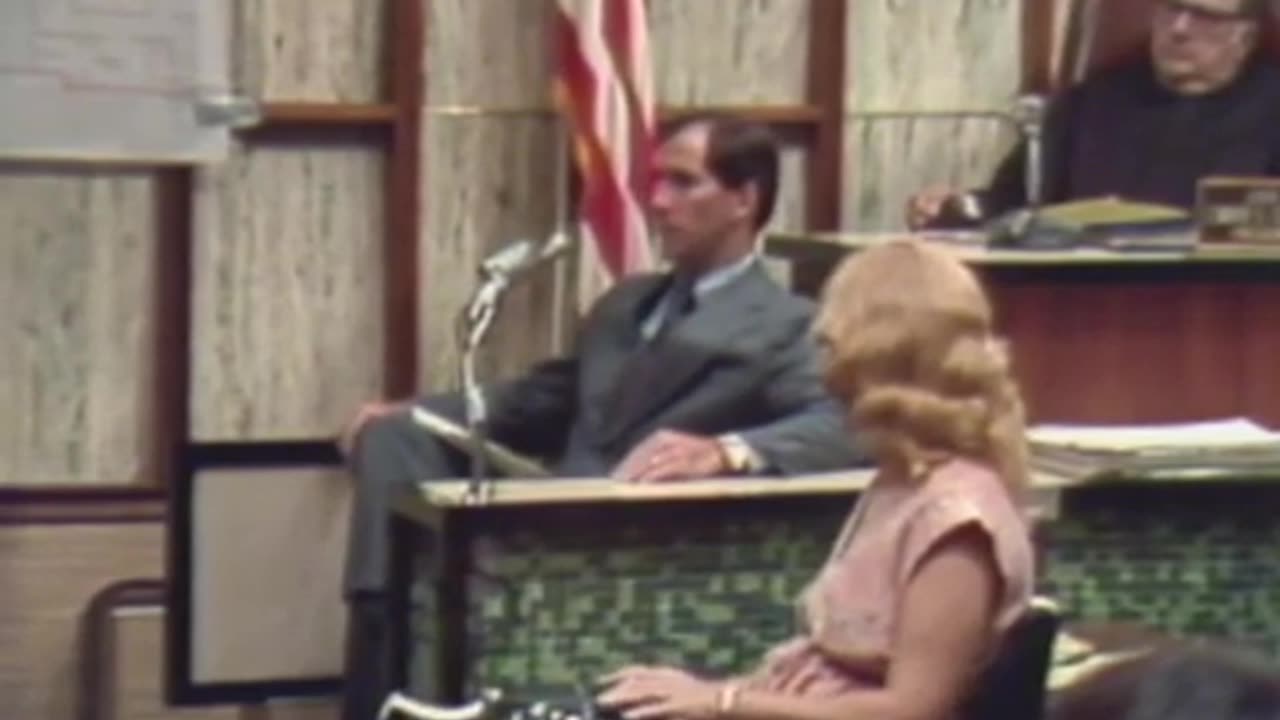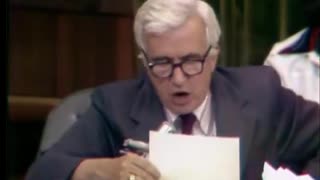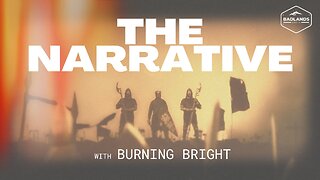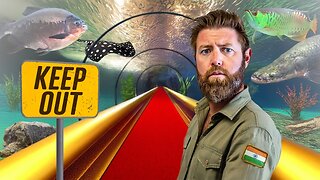Premium Only Content

The Ted Bundy Trials - Part 2 (July 5, 1979 to July 12, 1979)
The dark side of history: https://thememoryhole.substack.com/
Shortly after midnight on January 4, 1974, around the time that he terminated his relationship with Edwards, Bundy entered the basement apartment of 18-year-old Karen Sparks[80] (often identified as Joni Lenz,[81][82] Mary Adams,[83] and Terri Caldwell[84] in Bundy literature), a dancer and student at UW in the University District, Seattle. After bludgeoning Sparks with a metal rod from her bed frame, he sexually assaulted her with the same rod[68][85][82] causing extensive internal injuries and rupturing her bladder. She remained unconscious in the hospital for ten days[84] and although she survived, she was left with permanent brain damage, with significant loss to her vision and hearing. In the early morning hours of February 1, Bundy broke into the basement room of 21-year-old Lynda Ann Healy, a UW undergraduate who broadcast morning radio weather reports for skiers. He beat her unconscious; dressed her in blue jeans, a white blouse, and boots; and carried her away.[86] Bundy stated he drove Healy to a secluded area, where he raped and murdered her before dumping her body.[87]
During the first half of 1974, female college students disappeared at the rate of about one per month. On March 12, Donna Gail Manson, a 19-year-old student at Evergreen State College in Olympia, 60 miles (95 km) southwest of Seattle, left her dormitory to attend a jazz concert on campus but never arrived.[88] Bundy claimed that he burned Manson's skull in his girlfriend's fireplace "down to the last ash" in "a fit of... paranoia and cleanliness".[89] On April 17, 18-year-old Susan Elaine Rancourt disappeared while on her way to her dorm room after an evening advisors' meeting at Central Washington State College in Ellensburg, 110 miles (175 km) southeast of Seattle.[88][90] Two female Central Washington students later came forward to report encounters—one on the night of Rancourt's disappearance, the other three nights earlier—with a man wearing a sling, who was asking for help carrying a load of books to his brown or tan Volkswagen Beetle.[91][92]
On May 6, Roberta Kathleen Parks, 22, left her dormitory at Oregon State University in Corvallis,[93] 260 miles (420 km) south of Seattle, to have coffee with friends at the Memorial Union, but never arrived.[94] Bundy claimed that he spotted Parks in the cafeteria and persuaded her to go with him to a bar. After they got into his car, he tied up and gagged her and drove her back to Washington to be killed, raping her twice on the way.[95] Investigators from Seattle and King County grew increasingly concerned. There was no significant physical evidence, and the missing women had little in common apart from similar appearance: young, attractive, white college students with long hair parted in the middle.[96] On June 1, Brenda Carol Ball, 22, disappeared after leaving the Flame Tavern in Burien, near Seattle–Tacoma International Airport. She was last seen in the parking lot, talking to a brown-haired man with his arm in a sling.[97] Bundy stated he brought Ball back to his residence where they had a "consensual" sexual encounter before he strangled her while she was sleeping; although this failed to explain the damage done to her skull.[98]
In the early hours of June 11, 18-year-old UW student Georgann Hawkins vanished while walking down a brightly lit alley between her boyfriend's dormitory residence and her sorority house.[99] The next morning, three Seattle homicide detectives and a criminalist combed the entire alleyway on their hands and knees, finding nothing.[100] Bundy later told Keppel that he lured Hawkins to his car and knocked her unconscious with a crowbar. After handcuffing her, he drove her to Issaquah, a suburb 20 miles (30 km) east of Seattle, where he strangled her and spent the entire night with her body.[101][102] The next afternoon he returned to the UW alley and, in the very midst of a major crime scene investigation, located and gathered Hawkins's earrings and one of her shoes where he had left them in the adjoining parking lot and departed, unobserved. "It was a feat so brazen," wrote Keppel, "that it astonishes police even today."[103] Bundy said he revisited Hawkins's corpse on three occasions.[104]
After Hawkins's disappearance was publicized, witnesses came forward to report seeing a man on crutches, with a leg cast and carrying a briefcase, in an alley behind a nearby dormitory on the night of her disappearance.[105] One woman recalled that the man asked her to help him carry the case to his car, a light brown Volkswagen Beetle.[106] During this period, Bundy was working in Olympia as the assistant director of the Seattle Crime Prevention Advisory Commission, where he wrote a pamphlet for women on rape prevention.[107] Later, he worked at the Department of Emergency Services (DES), a state government agency involved in the search for the missing women. At the DES he met and began dating Carole Ann Boone (1947–2018), a twice-divorced mother of two who would play an important role in the final phase of his life six years later.[108]
A light tan rusty Volkswagen is positioned for display behind a chain made of handcuffs
Bundy's 1968 Volkswagen Beetle, in which he committed many of his crimes. The vehicle was on display at the now-defunct National Museum of Crime and Punishment,[109][110] and is now at the Alcatraz East Crime Museum in Pigeon Forge, Tennessee.[111]
Reports of the brutal attack on Sparks and the six missing women appeared prominently in newspapers and on television throughout Washington and Oregon.[112] Fear spread among the population; hitchhiking by young women dropped sharply.[113] Pressure mounted on law enforcement agencies,[114] but the scarcity of physical evidence severely hampered them. Police would not provide reporters with the little information that was available for fear of compromising the investigation.[115] Further similarities between the victims were noted: the disappearances all took place at night, usually near ongoing construction work, and were within a week of midterm or final exams. All of the victims were wearing slacks or blue jeans when they disappeared, and at many crime scenes there were sightings of a man wearing a cast or a sling and driving a brown or tan Volkswagen Beetle.[116]
The Oregon and Washington murders culminated on July 14 with the broad daylight abductions of two women from a crowded beach at Lake Sammamish State Park in Issaquah.[117] Four female witnesses described an attractive young man wearing a white tennis outfit with his left arm in a sling, speaking with a light accent, perhaps Canadian or British. Introducing himself as "Ted," he asked their help in unloading a sailboat from his tan or bronze-colored Volkswagen Beetle. Three refused; one accompanied him as far as his car, saw that there was no sailboat, and fled. Three additional witnesses saw him approach Janice Ann Ott, 23, a probation caseworker at the King County Juvenile Court, with the sailboat story and watched her leave the beach in his company.[118] About four hours later, Denise Marie Naslund, a 19-year-old woman who was studying to become a computer programmer, left a picnic to go to the restroom and never returned.[119] Bundy told Stephen Michaud and FBI agent William Hagmaier that Ott was still alive when he returned with Naslund and that he forced one to watch as he assaulted and murdered the other,[120][121][122] but he later denied it in an interview with Lewis on the eve of his execution.[123]
King County police, finally armed with a detailed description of their suspect and his car, posted fliers throughout the Seattle area. A composite sketch was printed in regional newspapers and broadcast on local television stations. Kloepfer, Rule, a DES employee, and a UW psychology professor all recognized the profile, the sketch, and the car, and reported Bundy as a possible suspect;[124] but detectives—who were receiving up to 200 tips per day[125]—thought it unlikely that a clean-cut law student with no adult criminal record could be the perpetrator.[126] On September 6, two grouse hunters stumbled across the skeletal remains of Ott and Naslund near a service road in Issaquah, 2 miles (3 km) east of Lake Sammamish State Park.[117][127] An extra femur and several vertebrae found at the site were later identified by Bundy as those of Hawkins.[128] Six months later, forestry students from Green River Community College discovered the skulls and mandibles of Healy, Rancourt, Parks, and Ball on Taylor Mountain, where Bundy frequently hiked, just east of Issaquah. Manson's remains were never recovered.[129]
Idaho, Utah, Colorado
565 First Avenue, Salt Lake City, UT
Rooming house in Salt Lake City where Bundy lived from September 1974 to October 1975, showing the fire escape used to sneak into his room and windows to the utility room where he concealed photo souvenirs of his murders[130]
In August 1974, Bundy received a second acceptance from the University of Utah Law School and moved to Salt Lake City, leaving Kloepfer in Seattle. While he called Kloepfer often, he dated "at least a dozen" other women.[131] As he studied the first-year law curriculum a second time, he was devastated to find out that the other students "had something, some intellectual capacity", that he did not. He found the classes completely incomprehensible. "It was a great disappointment to me," he said.[132] A new string of homicides began the following month, including two that would remain undiscovered until Bundy confessed to them shortly before his execution.
On September 2, Bundy raped and strangled a still-unidentified hitchhiker in Idaho, then returned the next day to photograph and dismember the corpse before disposing of the remains in a nearby river.[133][134][135] On October 2, he abducted 16-year-old Nancy Wilcox in Holladay, Utah, a suburb of Salt Lake City.[136][137] Bundy confessed that Wilcox was walking on a poorly lit "main roadway" when he parked his car and forced her into an orchard. He then restrained her and put her into his vehicle and drove back to his apartment, where he allegedly kept her for 24 hours.[138] Bundy informed investigators that her remains were buried near Capitol Reef National Park, some 200 miles (320 km) south of Holladay, but they were never found.[139]
On October 18, Melissa Anne Smith—the 17-year-old daughter of the police chief of Midvale, another Salt Lake City suburb—disappeared after leaving a pizza parlor at around 9.30 p.m. Her nude body was found in a nearby mountainous area nine days later; post-mortem examination indicated that she may have remained alive for up to seven days following her disappearance.[140][141] On October 31, Laura Ann Aime, also 17, disappeared 25 miles (40 km) south of Lehi after leaving a Halloween party by herself just after midnight; she was last seen trying to hitchhike.[142] Her naked body was found by hikers 9 miles (14 km) to the northeast in American Fork Canyon on Thanksgiving Day.[143] The medical examiner estimated that Aime had died on November 20; twenty days after her disappearance. Both Smith and Aime had been beaten, raped, sodomized, and strangled with nylon stockings.[144][145] Years later, Bundy described his post-mortem rituals with the corpses of Smith and Aime, including hair shampooing and application of makeup.[146][147]
In the late afternoon of November 8, Bundy approached 18-year-old telephone operator Carol DaRonch at Fashion Place Mall in Murray,[148] less than a mile from the Midvale restaurant where Smith was last seen. He identified himself as "Officer Roseland" of the Murray Police Department and told DaRonch that someone had attempted to break into her car. He asked her to accompany him to the station to file a complaint. When DaRonch pointed out to Bundy that he was driving on a road that did not lead to the police station, he immediately pulled onto the shoulder and attempted to handcuff her. During their struggle, he inadvertently fastened both handcuffs to the same wrist, and DaRonch was able to open the car door and escape.[149]
Later that evening, Debra Jean Kent, a 17-year-old student at Viewmont High School in Bountiful, 20 miles (30 km) north of Murray, disappeared after leaving a theater production at the school to pick up her brother.[150] The school's drama teacher and a student told police that "a stranger" had asked each of them to come out to the parking lot to identify a car. Another student later saw the same man pacing in the rear of the auditorium, and the drama teacher spotted him again shortly before the end of the play.[151] Outside the auditorium, investigators found a key that unlocked the handcuffs removed from DaRonch's wrist.[152] Bundy eventually admitted to abducting Kent and keeping her at his apartment for a day, stating she was alive "during half of it".[153]
In November, Kloepfer called King County police a second time after reading that young women were disappearing in towns surrounding Salt Lake City. Detective Randy Hergesheimer of the Major Crimes division interviewed her in detail. By then, Bundy had risen considerably on the King County hierarchy of suspicion, but the Lake Sammamish witness considered most reliable by detectives failed to identify him from a photo lineup.[154] In December, Kloepfer called the Salt Lake County Sheriff's Office and repeated her suspicions. Bundy's name was added to their list of suspects, but at that time no credible forensic evidence linked him to the Utah crimes.[155] In January 1975, Bundy returned to Seattle after his final exams and spent a week with Kloepfer, who did not tell him that she had reported him to police on three occasions. She made plans to visit him in Salt Lake City in August.[156]
A smiling young woman with short hair parted on the side
Caryn Campbell: Bundy's 14th documented murder victim and the subject of his first homicide indictment
In 1975, Bundy shifted much of his criminal activity eastward, from his base in Utah to Colorado. On January 12, a 23-year-old registered nurse named Caryn Eileen Campbell disappeared while walking down a well-lit hallway between the elevator and her room at the Wildwood Inn (now the Wildwood Lodge) in Snowmass Village, 400 miles (640 km) southeast of Salt Lake City.[157] Her nude body was found a month later next to a dirt road just outside the resort. According to the coroner's report, she had been killed by blows to her head from a blunt instrument that left distinctive linear grooved depressions on her skull; her assailant had slit her left earlobe and her body also bore deep cuts from a sharp weapon.[158]
On March 15, 100 miles (160 km) northeast of Snowmass, Vail ski instructor Julie Lyle Cunningham, 26, disappeared while walking from her apartment to a dinner date with a friend. Bundy later told Colorado investigators that he approached Cunningham on crutches and asked her to help carry his ski boots to his car, where he clubbed and handcuffed her before sexually assaulting her at a secondary site near Rifle, 90 miles (140 km) west of Vail. [159][160] Weeks later, he made the six-hour drive from Salt Lake City to revisit her remains.[160][161]
Denise Lynn Oliverson, 25, disappeared near the Utah–Colorado border in Grand Junction on April 6 while riding her bicycle to her parents' house; her bike and sandals were found under a viaduct near a railroad bridge.[162] Bundy stated he abducted Oliverson, killed her in his car near the Utah state line, and dumped her body in the Colorado River. This admission was supported by gas receipts, which showed that he was in the city on the same day that Oliverson went missing. On May 6, Bundy parked outside of the Alameda Junior High School in Pocatello, Idaho, 160 miles (255 km) north of Salt Lake City, and after seeing 12-year-old Lynette Dawn Culver walking along by herself, he lured her into his vehicle before driving her to his Holiday Inn hotel room.[163] He then raped Culver and drowned her in the bathtub. He disposed of her body in the Snake River north of Pocatello. Bundy reportedly provided intimate details about Lynette's personal life in his confession.[164][165]
An outdoor hallway. Hotel rooms are on the left and a balcony is on the right.
Caryn Campbell disappeared while walking down this brightly lit hallway to her hotel room.
In mid-May, three of Bundy's Washington State DES co-workers, including Boone, visited him in Salt Lake City and stayed for a week in his apartment. He subsequently spent a week in Seattle with Kloepfer in early-June and they discussed getting married the following Christmas. Again, Kloepfer made no mention of her multiple discussions with authorities in King County and Salt Lake County. Bundy disclosed neither his ongoing relationship with Boone nor a concurrent romance with a Utah law student (known in various accounts as either Kim Andrews[166] or Sharon Auer[167]).
On June 28, 15-year-old Susan Curtis vanished from the campus of Brigham Young University in Provo, 45 miles (70 km) south of Salt Lake City. Her murder became Bundy's last confession, tape-recorded moments before he entered the execution chamber.[168] The bodies of victims Wilcox, Kent, Cunningham, Oliverson, Culver, and Curtis were never recovered. In August 1975, Bundy was baptized into the Church of Jesus Christ of Latter-day Saints, although he was not an active participant in services and ignored most church restrictions.[169][170][171] He would later be excommunicated by the LDS Church following his 1976 kidnapping conviction.[169] When asked his religious preference after his arrest, Bundy answered "Methodist", the religion of his childhood.[172]
In Washington State, investigators were still struggling to analyze the Pacific Northwest murder spree that had ended as abruptly as it had begun. In an effort to make sense of an overwhelming mass of data, they resorted to the then-innovative strategy of compiling a database. They used the King County payroll computer, a "huge, primitive machine" by contemporary standards, but the only one available for their use. After inputting the many lists they had compiled—classmates and acquaintances of each victim, Volkswagen owners named "Ted", known sex offenders, and so on—they queried the computer for coincidences. Out of thousands of names, 26 turned up on four lists; one was Bundy. Detectives also manually compiled a list of their 100 "best" suspects, and Bundy was on that list as well. He was "literally at the top of the pile" of suspects when word came from Utah of his arrest.[173]
-
 3:50:14
3:50:14
The Memory Hole
5 months agoNixon Impeachment Hearings Day 2 (1974-07-24)
1.06K -
 1:49:44
1:49:44
Russell Brand
4 days agoTerrence Howard’s SHOCKING New Theory of Reality - SF599
240K75 -
 6:36:43
6:36:43
DopeFrags
7 hours agoWe're just gamin'.. | Dope After Dark
11.9K -
 LIVE
LIVE
EleMentalMJ
5 hours agoSUNDAY FUNDAY! - Variety Gaming Stream
68 watching -
 15:40
15:40
TimcastIRL
17 hours agoDemocrat Party Is DONE, Donors FLEE As Dems Face Approval Rating DISASTER
67.9K136 -
 2:44:38
2:44:38
Laura Loomer
10 hours agoEP128: Iran's Nuclear Program Goes BOOM
159K172 -
 3:20:44
3:20:44
Badlands Media
1 day agoThe Narrative Ep. 27 - A Spectacular Success
127K21 -
 1:21:56
1:21:56
Man in America
19 hours agoExposing Big Pharma’s #1 WEAPON for Keeping You SICK w/ Dr. Edward Group
80.9K27 -
 15:53
15:53
Forrest Galante
1 day agoPrivate Tour of India’s Best Secret Aquarium
142K12 -
 5:44:01
5:44:01
Spartan
13 hours agoPro Halo Player | Sens Crisis Grind | Ranked Arena, Probably SWTOR at some point
71.3K